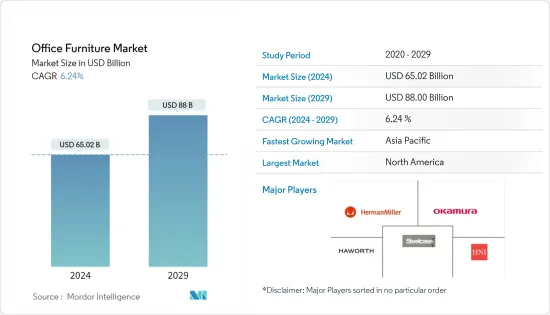|
|
市場調査レポート
商品コード
1433776
オフィス家具:市場シェア分析、産業動向と統計、成長予測(2024年~2029年)Office Furniture - Market Share Analysis, Industry Trends & Statistics, Growth Forecasts (2024 - 2029) |
||||||
カスタマイズ可能
適宜更新あり
|
|||||||
| オフィス家具:市場シェア分析、産業動向と統計、成長予測(2024年~2029年) |
|
出版日: 2024年02月15日
発行: Mordor Intelligence
ページ情報: 英文 120 Pages
納期: 2~3営業日
|
全表示
- 概要
- 目次
オフィス家具市場規模は2024年に650億2,000万米ドルと推計され、2029年には880億米ドルに達し、市場推計・予測期間(2024-2029年)のCAGRは6.24%で成長すると予測されます。

オフィス家具は、世界中の発展途上国や低開発国におけるビジネス環境の拡大に伴い、その重要性を増しています。米国、中国、インドなどの国々では、改築や改造プロジェクトが増加しており、市場の成長を後押ししています。さらに、アジアや中東における外国直接投資や貿易緩和など、各国間の良好な貿易関係や政府の政策が、多国籍企業や世界企業、テクノロジー・ビジネスパークの数を増やし、市場の収益取引の増加に貢献しています。
住宅、オフィス、商業施設の建設が増加していることは、調査期間を通じて市場の成長に影響を与える重要な要因の1つです。この動向は予測期間中も続くと予想されます。さらに、COVID-19の流行により、多くの企業がリモートワークに切り替えました。従業員の大半はオフィスでの勤務を徐々に再開しており、これが市場の成長を加速させると予想されます。ITパークや商業ゾーンの急速な建設による企業オフィスの増加は、世界的に近代化されたオフィス家具の需要を生み出しています。同僚とのコミュニケーションを促進し、社交的な交流を通じて協力的な環境を作るため、組織は非公式なオフィス空間を作りつつあります。このシフトにより、市場のメーカーはインテリジェントに設計された家具製品を導入するよう研究しています。
オフィス家具市場の動向
eコマースの拡大が市場の収益拡大に貢献
調査期間中、顧客はビジネスニーズのために徐々にeコマース・チャネルに切り替えるようになり、希望する製品や価格を比較するために実店舗を訪れる回数を減らすのに役立っています。また、コストを削減し、利益率を高めるために、オンライン小売戦略を採用するベンダーも増えています。さらに、レンタルスペースや在庫の必要性を最小限に抑えるため、オンライン家具店も増えています。Amazon.comやWayfairは、オフィス家具の大手オンライン小売業者です。オンラインチャネルを通じたオフィス家具販売の成長機会により、オンライン小売業者は、安全性と信頼性の面で購入プロセスを改善する必要に迫られ、オフィス家具の需要を促進しました。消費者のオンライン購入を促進する政策には、安全な取引、代金引換オプション、便利な返品政策、統合され集中化された顧客サービスなどがあります。
アジア太平洋地域がオフィス家具市場で力強い成長を遂げる
アジア太平洋地域は、世界のオフィス家具市場において最も急速に成長している地域です。中国、日本、オーストラリア、インドが同地域の貢献上位国です。オフィス家具市場の主要プレイヤーの多くは、流通網を強化するためにeコマース小売店とパートナーシップを結んでいます。オフィス家具の需要は、商業施設やサービス業における雇用の急激な増加に伴い増加しました。新興企業や事業拡張の増加も、同地域の市場成長を促進すると予想される要因の1つです。同地域での増加は、オフィス賃貸と雇用の需要の高まりによって促進されると予想されます。さらに、アジア太平洋地域における多国籍企業の進出は、同地域のオフィス家具市場の成長を後押しすると期待されています。
オフィス家具産業の概要
本レポートでは、オフィス家具市場で事業を展開する主要な国際企業を取り上げています。市場シェアでは、現在いくつかの大手企業が市場を独占しています。しかし、技術の進歩や製品の革新に伴い、中堅から中小の企業が新規契約の獲得や新規市場の開拓によって市場での存在感を高めています。
その他の特典:
- エクセル形式の市場予測(ME)シート
- 3ヶ月間のアナリスト・サポート
目次
第1章 イントロダクション
- 調査の前提条件と市場定義
- 調査範囲
第2章 調査手法
第3章 エグゼクティブサマリー
第4章 市場の洞察と力学
- 市場概要
- 市場促進要因
- 市場抑制要因
- 市場機会
- 産業バリューチェーン分析
- ポーターのファイブフォース分析
- オフィス家具の材料使用に関する洞察
- COVID-19が市場に与える影響
第5章 市場セグメンテーション
- タイプ
- シート
- テーブル
- 収納
- デスク
- その他オフィス家具
- 流通チャネル
- ホームセンター
- 旗艦店
- 専門店
- オンラインストア
- その他の流通チャネル
- 地域
- 北米
- 南米
- 欧州
- アジア太平洋
- 中東・アフリカ
第6章 競合情勢
- 市場競合概要
- 企業プロファイル
- Okamura Corporation
- HNI Corporation
- Herman Miller Inc.
- Haworth Inc.
- Global Furniture Group
- Steelcase Inc.
- Knoll Inc.
- Kimball International
- 9to5 Seating
- KOKUYO Co. Ltd*
第7章 市場の将来
第8章 免責事項
The Office Furniture Market size is estimated at USD 65.02 billion in 2024, and is expected to reach USD 88 billion by 2029, growing at a CAGR of 6.24% during the forecast period (2024-2029).

Office furniture is gaining more significance, with the expanding business environment in the developing and underdeveloped nations across the world. The number of renovation and modification projects is increasing in countries, such as the United States, China, and India, fueling the market's growth. Moreover, favorable trade relations between countries and government policies, such as foreign direct investment and trade relaxations in Asia and the Middle East, increased the number of multinational and global companies and technology and business parks, helping the market record more revenue transactions.
The increasing construction of residences, offices, and commercial complexes is one of the significant factors influencing the market's growth throughout the study period. This trend is anticipated to continue in the forecast period as well. Moreover, owing to the COVID-19 pandemic, many companies switched to remote working practices. The majority of employees have been resuming their working at office routine slowly, which is anticipated to accelerate the market's growth. An increase in the number of corporate offices, owing to the rapid construction of IT parks and commercial zones, creates a demand for modernized office furniture globally. To boost colleague communications and create a collaborative environment through social interactions, organizations are creating informal office spaces. This shift has prompted manufacturers in the market studied to introduce intelligently designed furniture products.
Office Furniture Market Trends
Growing E-Commerce is Helping the Market to Record More Revenue
During the study period, customers gradually started switching to the e-commerce channels for their business needs, which helps reduce the number of times they need to visit the physical retail stores to compare their desired products and prices. More vendors are also adapting to online retail strategies to reduce costs and increase their profit margins. Moreover, there is a rise in online furniture stores to minimize the need for rental space and inventory. Amazon.com and Wayfair are some of the leading online retailers for office furniture. The growth opportunity for the sales of office furniture through online channels forced online retailers to improve purchase processes in terms of security and reliability, which propelled the demand for office furniture. Some of the policies that encourage consumers to purchase online include secured transactions, cash-on-delivery options, convenient return policies, and integrated and centralized customer service.
Asia-Pacific to Witness Strong Growth in the Office Furniture Market
Asia-Pacific is the fastest-growing region in the global office furniture market. China, Japan, Australia, and India are the top contributing countries in the region. Many key players in the office furniture market are entering partnerships with e-commerce retail stores to strengthen their distribution network. The demand for office furniture increased with an exponential rise in commercial properties and employments in the service sector. An increasing number of start-ups and business expansions is another factor expected to drive the market's growth in the region. The increase in the region is anticipated to be fostered by the rising demand for office leasing and employment. Moreover, the expansion of multinational companies in Asia-Pacific is expected to boost the growth of the office furniture market in the region.
Office Furniture Industry Overview
The report covers major international players operating in the office furniture market. In terms of market share, some of the major players currently dominate the market. However, with technological advancement and product innovation, mid-size to smaller companies are increasing their market presence by securing new contracts and tapping new markets.
Additional Benefits:
- The market estimate (ME) sheet in Excel format
- 3 months of analyst support
TABLE OF CONTENTS
1 INTRODUCTION
- 1.1 Study Assumptions and Market Definition
- 1.2 Scope of the Study
2 RESEARCH METHODOLOGY
3 EXECUTIVE SUMMARY
4 MARKET INSIGHTS AND DYNAMICS
- 4.1 Market Overview
- 4.2 Market Drivers
- 4.3 Market Restraints
- 4.4 Market Opportunities
- 4.5 Industry Value Chain Analysis
- 4.6 Porters Five Force Analysis
- 4.7 Insights on Material Usage in Office Furniture
- 4.8 Impact of COVID-19 on the Market
5 MARKET SEGMENTATION
- 5.1 Type
- 5.1.1 Seating
- 5.1.2 Tables
- 5.1.3 Storage
- 5.1.4 Desks
- 5.1.5 Other Office Furniture
- 5.2 Distribution Channel
- 5.2.1 Home Centers
- 5.2.2 Flagship Stores
- 5.2.3 Specialty Stores
- 5.2.4 Online Stores
- 5.2.5 Other Distribution Channels
- 5.3 Geography
- 5.3.1 North America
- 5.3.2 South America
- 5.3.3 Europe
- 5.3.4 Asia-Pacific
- 5.3.5 Middle-East and Africa
6 COMPETITIVE LANDSCAPE
- 6.1 Market Competition Overview
- 6.2 Company Profiles
- 6.2.1 Okamura Corporation
- 6.2.2 HNI Corporation
- 6.2.3 Herman Miller Inc.
- 6.2.4 Haworth Inc.
- 6.2.5 Global Furniture Group
- 6.2.6 Steelcase Inc.
- 6.2.7 Knoll Inc.
- 6.2.8 Kimball International
- 6.2.9 9to5 Seating
- 6.2.10 KOKUYO Co. Ltd*






